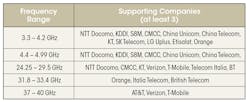Lots of new frequency bands will factor into the official 5G standard scheduled for publication in September next year. These include lower bands neighboring 4G frequencies to higher millimeter waves with enough breathing room to enable better coverage and capacity, experts say.
The 3GPP – which sets communication standards – is drafting an intermediate standard that shifts 4G networks into higher and lightly-used frequency bands. If all goes according to plan, the Non-Standalone standard will be published months before the new 5G radio, giving companies additional space for mobile traffic with little more than a software upgrade.
“Many LTE bands will be redeployed for new radio,” said Nikhail Kundargi, a senior wireless platform architect at National Instruments, in a presentation at the NI Week conference last month. “We have not finished distilling these frequencies into band combinations or band numbers yet, but we are working on it.”
Kundargi presented the table below to highlight the frequency bands that wireless carriers are targeting for the new 5G radio.
These bands will be used in official 3GPP standards, which contrast from the trailblazing (or impatient) specifications that companies have published for trials. This year, Verizon published 5G specs, while South Korean telecoms are already writing their own for the Winter Olympics in Seoul next year.
The major application for Non-Standalone 5G is fixed wireless access, which could replace expensive fiber optic cables. The intermediate 5G standard – which will be finished later this year and deployed next March – is targeting bands under 6 GHz, as well as the millimeter waves to be used in the new radio.
The 3.5 GHz band is one to keep an eye on, Kundargi said. For years, it has been reserved in the U.S. for military applications. But telecom regulators voted last year to open it for spectrum sharing experiments, in which the public could access the frequency band as long as the Department of Defense is offline.
Other bands under consideration for the first phase of Release 15 – the 3GPP’s name for the official 5G standard – include 52 GHz and 70 GHz, which Nokia targeted as long ago as 2012. AT&T has also been testing the 28 GHz band with a unique channel sounder that rolls through cities to better understand how millimeter waves interact with trees, walls, and people.
"The 3GPP will study how these bands work together [with lower bands] because depending on how you put them together you might have harmonics," said Kundargi. "Non-standalone 5G will pair an LTE and a new radio band. The anchor, for instance, will be the 3 GHz band while your data connectivity resides in the 28 GHz band."
About the Author

James Morra
Senior Editor
James Morra is the senior editor for Electronic Design, covering the semiconductor industry and new technology trends, with a focus on power electronics and power management. He also reports on the business behind electrical engineering, including the electronics supply chain. He joined Electronic Design in 2015 and is based in Chicago, Illinois.

